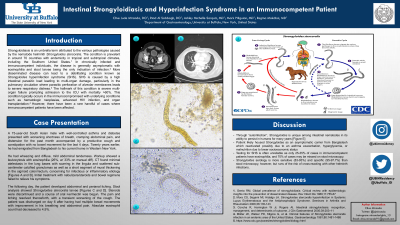Back


Poster Session A - Sunday Afternoon
Category: Small Intestine
A0650 - Intestinal Strongyloidiasis and Hyperinfection Syndrome in an Immunocompetent Patient
Sunday, October 23, 2022
5:00 PM – 7:00 PM ET
Location: Crown Ballroom

Has Audio

Clive J. Miranda, DO
University at Buffalo
Buffalo, NY
Presenting Author(s)
Clive J. Miranda, DO, Riad Al Sabbagh, DO, Ashley M. Sarquiz, MD, Mark Piliguian, MD, Danielle Reber, BS, Regina Makdissi, MD
University at Buffalo, Buffalo, NY
Introduction: Strongylodiasis is a term attributed to the many pathologies caused by the nematode helminth Strongyloides stercoralis. The condition is prevalent in around 70 countries with endemicity in tropical and subtropical climates, including the Southern United States. In chronically infected and immunocompetent individuals, the disease is generally asymptomatic with eosinophilia and stool larvae being the only indication of infection. A more disseminated form of the disease can lead to a debilitating condition known as Strongyloides hyperinfection syndrome (SHS), caused by a high intestinal parasitic load leading to multi-organ damage. SHS may reach 2% of patients with strongyloidiasis, typically occurring in the immunocompromised with underlying conditions such as hematologic neoplasias, advanced HIV, and organ transplantation. The risk of SHS in immunocompetent patients is not zero, however, as other conditions such as malnutrition, diabetes, chronic obstructive pulmonary disease, alcoholism, and chronic kidney disease are identifiable predisposing conditions for SHS.
Case Description/Methods: A 73-year-old South Asian male with well-controlled asthma and diabetes presented with worsening shortness of breath, cramping abdominal pain, and distension for the past month accompanied by a productive cough and constipation with no bowel movement for the last 4 days. Twenty years earlier, he had emigrated from Bangladesh to his current residence in the northeast United States. Initial exam was notable for wheezing and diffuse, mild abdominal tenderness. Workup showed a leukocytosis with eosinophilic predominance and computed tomography showed a short segment of mural thickening in the sigmoid colon/rectum. Treatment with nebulizers and bowel regimens failed to relieve his symptoms initially. Stool analysis was notable for the presence of rare Strongyloides stercoralis larvae and the patient was started on ivermectin with complete relief of pulmonary and gastrointestinal symptoms.
Discussion: SHS varies widely in symptomatology with gastrointestinal complaints ranging from abdominal pain to vomiting and watery diarrhea.. Strongyloides is unique among intestinal nematodes in its ability to persist in humans for many years. Most cases of infection in diabetics are in those individuals with poor sugar control. Our case appears to be a waning of immunity in a likely chronic, asymptomatic strongyloidiasis patient housing the parasite since emigration from South Asia leading to SHS requiring urgent medical care.

Disclosures:
Clive J. Miranda, DO, Riad Al Sabbagh, DO, Ashley M. Sarquiz, MD, Mark Piliguian, MD, Danielle Reber, BS, Regina Makdissi, MD. A0650 - Intestinal Strongyloidiasis and Hyperinfection Syndrome in an Immunocompetent Patient, ACG 2022 Annual Scientific Meeting Abstracts. Charlotte, NC: American College of Gastroenterology.
University at Buffalo, Buffalo, NY
Introduction: Strongylodiasis is a term attributed to the many pathologies caused by the nematode helminth Strongyloides stercoralis. The condition is prevalent in around 70 countries with endemicity in tropical and subtropical climates, including the Southern United States. In chronically infected and immunocompetent individuals, the disease is generally asymptomatic with eosinophilia and stool larvae being the only indication of infection. A more disseminated form of the disease can lead to a debilitating condition known as Strongyloides hyperinfection syndrome (SHS), caused by a high intestinal parasitic load leading to multi-organ damage. SHS may reach 2% of patients with strongyloidiasis, typically occurring in the immunocompromised with underlying conditions such as hematologic neoplasias, advanced HIV, and organ transplantation. The risk of SHS in immunocompetent patients is not zero, however, as other conditions such as malnutrition, diabetes, chronic obstructive pulmonary disease, alcoholism, and chronic kidney disease are identifiable predisposing conditions for SHS.
Case Description/Methods: A 73-year-old South Asian male with well-controlled asthma and diabetes presented with worsening shortness of breath, cramping abdominal pain, and distension for the past month accompanied by a productive cough and constipation with no bowel movement for the last 4 days. Twenty years earlier, he had emigrated from Bangladesh to his current residence in the northeast United States. Initial exam was notable for wheezing and diffuse, mild abdominal tenderness. Workup showed a leukocytosis with eosinophilic predominance and computed tomography showed a short segment of mural thickening in the sigmoid colon/rectum. Treatment with nebulizers and bowel regimens failed to relieve his symptoms initially. Stool analysis was notable for the presence of rare Strongyloides stercoralis larvae and the patient was started on ivermectin with complete relief of pulmonary and gastrointestinal symptoms.
Discussion: SHS varies widely in symptomatology with gastrointestinal complaints ranging from abdominal pain to vomiting and watery diarrhea.. Strongyloides is unique among intestinal nematodes in its ability to persist in humans for many years. Most cases of infection in diabetics are in those individuals with poor sugar control. Our case appears to be a waning of immunity in a likely chronic, asymptomatic strongyloidiasis patient housing the parasite since emigration from South Asia leading to SHS requiring urgent medical care.

Figure: [a] Iodine contrast staining of stool showing rhabditiform larva of Strongyloides stercoralis
[b] Fecal agar plate culture showing rhabditiform larva of Strongyloides stercoralis
[b] Fecal agar plate culture showing rhabditiform larva of Strongyloides stercoralis
Disclosures:
Clive Miranda indicated no relevant financial relationships.
Riad Al Sabbagh indicated no relevant financial relationships.
Ashley Sarquiz indicated no relevant financial relationships.
Mark Piliguian indicated no relevant financial relationships.
Danielle Reber indicated no relevant financial relationships.
Regina Makdissi indicated no relevant financial relationships.
Clive J. Miranda, DO, Riad Al Sabbagh, DO, Ashley M. Sarquiz, MD, Mark Piliguian, MD, Danielle Reber, BS, Regina Makdissi, MD. A0650 - Intestinal Strongyloidiasis and Hyperinfection Syndrome in an Immunocompetent Patient, ACG 2022 Annual Scientific Meeting Abstracts. Charlotte, NC: American College of Gastroenterology.
